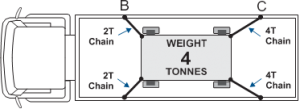This is a guide only, please check your local regulations and rules for upto date information.

Safe Loading
Proper balance between the car and the trailer is essential for a stable, safe towing combination. This includes the distribution of the load on the trailer and the load the trailer puts onto the back of the car.
The ideal load distribution on the trailer is to have the load concentrated slightly forward of the trailer's axle fine so that between 8 per cent and 15 per cent of the trailer weight is transferred downwards on the car's towbar. Too much weight on the back of the car will tend to lift the car's front wheels resulting in poor steering and braking. Conversely, if the centre of the load is behind the trailer axle line it will tend to lift the rear of the car and result in unstable handling and fishtailing.
Note: Horse floats are generally designed for a drawbar load of approximately 15 per cent to reduce the chance of the float lifting the rear of the towing vehicle.
Where the load is spread over the trailer it is important to keep heavier items near the centre of the trailer, both lengthways and sideways to reduce sway and increase trailer stability.
The load the trailer drawbar applies to the towbar should be checked at intervals during loading. In most cases it should still be possible to lift the trailer drawbar off the towbar ball with some effort. For very heavy trailers the jockey wheel can be used to remove the load from the car and by noting the amount the rear of the car comes back up, some assessment can be made of how much load the trailer is putting on the car.
Caution: The trailer drawbar should never lift off the towbar by itself. This is a highly unsafe and unstable load configuration.
On high trailers and caravans the load should be placed as low down as possible to reduce the tendency to sway or pitch. For example, overhead cupboards in caravans should only be used for light items. All loads must be properly secured.
Load-Distributing Hitches
In many cases for the higher towing loads the vehicle manufacturer recommends that a load-distributing hitch be used. These hitches allow higher loads to be placed on the towbar without reducing the load on the front wheels of the car. When the load-distributing hitch is correctly adjusted, the car should sit basically the same as it did before the trailer was attached.
Trailer load safety
When loaded, the centre of mass of a drawbar trailer, including its load, must be in
front of the centre of the axle group, to minimise trailer sway (see Figure B.9). This
means that the trailer coupling should push down on the towbar, not exceeding the
manufacturer’s ratings of the coupling and towbar.
![]()


![]()


A simple rule is to select lashings whose combined lashing capacity is:
-
- in the forward direction = twice the weight of load;
- in the sideways direction = the weight of load; and
- in the rearward direction = the weight of load.
This assumes the lashings are angled at less than 60 degrees to the appropriate direction of movement. However, lashings selected in this way will, in most cases, be stronger than necessary.
For example, to restrain a weight of 4 tonne (see Figure C.18) the following is required:
-
- in the forward direction, two chains (C & D) which are angled at 60 degrees or less to the rearward direction each with a lashing capacity of 4 tonnes;
- in the sideways direction, two chains (B & C or A & D) which are angled at 60 degrees or less to the sideways direction each with a minimum lashing capacity of 2 tonnes;
- in the rearward direction, two chains (A & B) which are angled at 60 degrees or less to the forward direction each with a lashing capacity of 2 tonnes.

For a complete guide on how to tie down a load on a small trailer or big trailer remains the same following the NATIONAL TRANSPORT COMMISSION National Restraint Guide, you can never go wrong.
